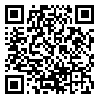دوره 15، شماره 2 - ( 12-1402 )
جلد 15 شماره 2 صفحات 210-199 |
برگشت به فهرست نسخه ها
Download citation:
BibTeX | RIS | EndNote | Medlars | ProCite | Reference Manager | RefWorks
Send citation to:



BibTeX | RIS | EndNote | Medlars | ProCite | Reference Manager | RefWorks
Send citation to:
Nobakhsh B, Shalbaf A, Rostami R, Kazemi R. Graph-based Analysis to Predict Repetitive Transcranial Magnetic Stimulation Treatment Response in Patients With Major Depressive Disorder Using EEG Signals. BCN 2024; 15 (2) :199-210
URL: http://bcn.iums.ac.ir/article-1-2628-fa.html
URL: http://bcn.iums.ac.ir/article-1-2628-fa.html
Graph-based Analysis to Predict Repetitive Transcranial Magnetic Stimulation Treatment Response in Patients With Major Depressive Disorder Using EEG Signals. مجله علوم اعصاب پایه و بالینی. 1402; 15 (2) :199-210
چکیده:
Introduction: Repetitive transcranial magnetic stimulation (rTMS) is a non-pharmacological treatment for drug-resistant major depressive disorder (MDD) patients. Since the success rate of rTMS treatment is about 50%-55%, it is essential to predict the treatment outcome before starting based on electroencephalogram (EEG) signals, leading to identifying effective biomarkers and reducing the burden of health care centers.
Methods: To this end, pretreatment EEG data with 19 channels in the resting state from 34 drug-resistant MDD patients were recorded. Then, all patients received 20 sessions of rTMS treatment, and a reduction of at least 50% in the total beck depression inventory (BDI-II) score before and after the rTMS treatment was defined as a reference. In the current study, effective brain connectivity features were determined by the direct directed transfer function (dDTF) method from patients’ pretreatment EEG data in all frequency bands separately. Then, the brain functional connectivity patterns were modeled as graphs by the dDTF method and examined with the local graph theory indices, including degree, out-degree, in-degree, strength, out-strength, in-strength, and betweenness centrality.
Results: The results indicated that the betweenness centrality index in the Fp2 node and the δ frequency band are the best biomarkers, with the highest area under the receiver operating characteristic curve value of 0.85 for predicting the rTMS treatment outcome in drug-resistant MDD patients.
Conclusion: The proposed method investigated the significant biomarkers that can be used to predict the rTMS treatment outcome in drug-resistant MDD patients and help clinical decisions.
Methods: To this end, pretreatment EEG data with 19 channels in the resting state from 34 drug-resistant MDD patients were recorded. Then, all patients received 20 sessions of rTMS treatment, and a reduction of at least 50% in the total beck depression inventory (BDI-II) score before and after the rTMS treatment was defined as a reference. In the current study, effective brain connectivity features were determined by the direct directed transfer function (dDTF) method from patients’ pretreatment EEG data in all frequency bands separately. Then, the brain functional connectivity patterns were modeled as graphs by the dDTF method and examined with the local graph theory indices, including degree, out-degree, in-degree, strength, out-strength, in-strength, and betweenness centrality.
Results: The results indicated that the betweenness centrality index in the Fp2 node and the δ frequency band are the best biomarkers, with the highest area under the receiver operating characteristic curve value of 0.85 for predicting the rTMS treatment outcome in drug-resistant MDD patients.
Conclusion: The proposed method investigated the significant biomarkers that can be used to predict the rTMS treatment outcome in drug-resistant MDD patients and help clinical decisions.
نوع مطالعه: Original |
موضوع مقاله:
Cognitive Neuroscience
دریافت: 1401/10/1 | پذیرش: 1402/4/11 | انتشار: 1402/12/11
دریافت: 1401/10/1 | پذیرش: 1402/4/11 | انتشار: 1402/12/11
| بازنشر اطلاعات | |
 |
این مقاله تحت شرایط Creative Commons Attribution-NonCommercial 4.0 International License قابل بازنشر است. |





